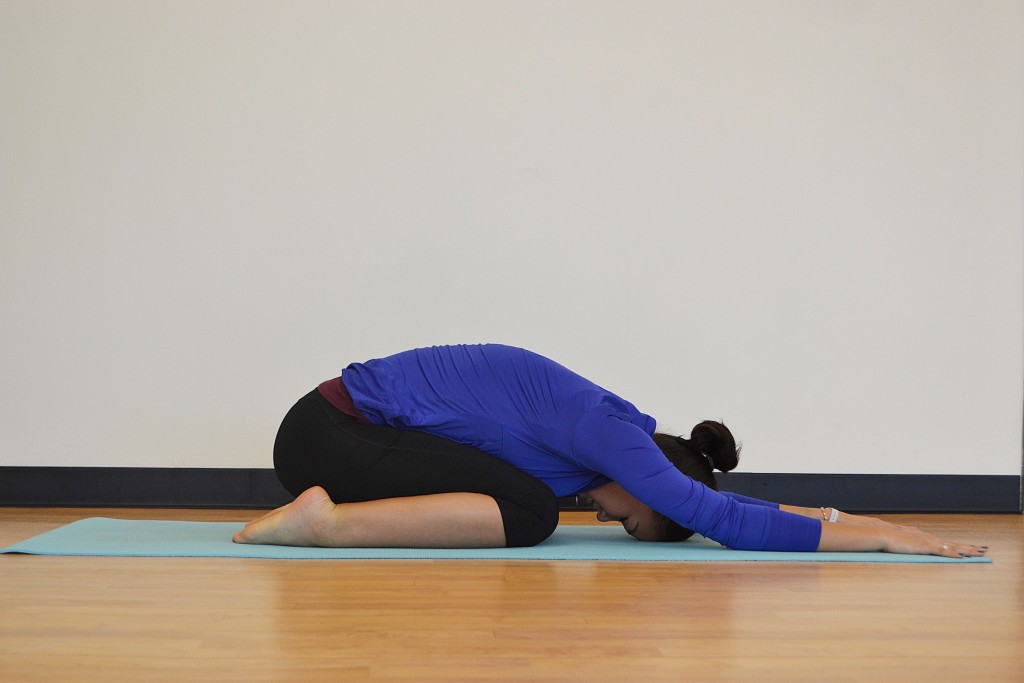
If you’ve always wanted to try yoga but never have, finals week is the perfect time to start. Not only can it be extremely relaxing, it may be just what you need to keep your sanity at the end of the semester. Courtney Chung, a yoga instructor at the East Gym and a senior majoring in English, chooses it as her method of stress reduction because it not only works her body, but allows her to interact with her spiritual and emotional health. To help us get in touch with our inner selves, Chung shared a few of her favorite yoga poses.
Child’s Pose
Sanskrit name: Balasana
Start in a kneeling position. Chung says that depending on how flexible you are, you can start with your feet apart or bring your big toes to meet right under your sacrum, which is the triangular-shaped bone at the base of your spine and connects your hip bones to form your pelvis. Neither position is easier; it just depends on what you find comfortable. Once you find a suitable position, rest your butt on or above your heels and allow your torso to fold forward and your head to drop toward the floor, almost touching chin to chest. While doing this, tuck your pelvis under to lengthen your spine. Your arms can either extend forward in front of you with your palms flat on the ground, or they can lay at your sides with your fingertips pointing behind you. In either position, Chung says you can imagine pushing your head, neck and shoulders down and into the floor, to help you spread your shoulder blades and stretch your spine.
Reclining Bound Angle Pose
Sanskrit name: Supta Baddha Konasana
Sitting up straight with your legs straight out in front of you, bend your knees and draw your heels in toward your pelvis without your feet leaving the ground. Allow your knees to open away from each other and drop toward the ground. Slowly recline backward, bringing your elbows to the ground, then lower your back all the way to the ground. Gently shift side to side on your butt to allow your spine to lengthen while maintaining the natural curvature of the lower back. Chung says you should allow your knees to relax and to not force them to touch the floor if they don’t do so naturally. Gently bring your shoulder blades inward and allow your arms to relax with a soft bend in your elbow, your forearms away from your body and with your palms facing the sky. If you need more support, Chung suggests placing your knees and thighs on either a yoga block, pillows or even folded blankets.
Upside-Down Pose
Sanskrit name: Viparita Karani
Chung says many people already do this pose, and she often sees people resting in this position while using their phones. Begin by facing a wall that is about a foot away in an upright seated position. Slowly lower your torso toward the ground and then raise the legs to lay against the wall. If this is comfortable you may stay here, or for an added stretch, you can slowly begin to push the body toward the wall until your hips form a right angle. If you have any pain or discomfort from resting your hips on the ground, Chung suggests supporting your lower spine by placing folded towels or blankets underneath the sacrum.
Downward Facing Frog Pose
Sanskrit Name: Adho Mukha Mandukasana
Begin by first settling into a tabletop position, where your hands are underneath your shoulders and your knees are stacked underneath your hips. Your back stays flat, and your gaze is between your hands. Rotating from your knee, allow your toes to point outward, with the instep of your feet on the ground. Slowly begin to widen your legs by walking your knees out to the sides, coming onto your forearms once you have found a comfortable position for your legs. Keeping your elbows underneath your shoulders, Chung says you can push your body far back enough so that you feel a small stretch in your inner thighs. You can also create movement by slowly rocking your body back and forth. Chung added that this is one of her favorite poses, but she warns that if you do have a lot of tension in your hips or lack flexibility in this area, this pose may not be comfortable or easy for you to rest in.


